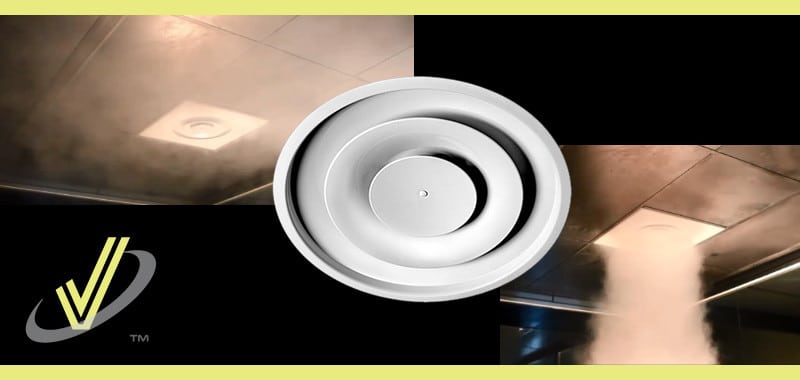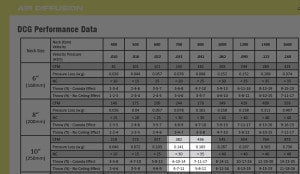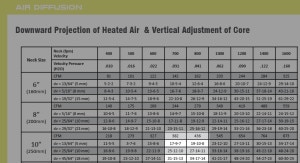
Tous les manufacturiers majeurs de diffuseurs d’air ont leur modèle de diffuseurs ronds pour plafonds commerciaux. Quoique certains soient fixes et d’autres ajustables, en acier ou en aluminium, ils ont tous un aspect très similaire.
EffectiV HVAC (CVAC Efficace) est une ligne de diffuseurs d’air innovateurs et spécialisés. Chacun de ses produits adresse des besoins spécifiques de design, de confort et/ou d’efficacité énergétique. C’est pourquoi on nous demande souvent : pourquoi le DCG?
D’accord, il est tout aluminium et ajustable, en plus d’être un des plus sinon le plus attrayant du point de vue esthétique. Mais tout de même, qu’est-ce que le rend si unique?
La réponse est : sa performance! DCG offre un très haut niveau d’ajustement vertical, peut-être le plus haut parmi sa catégorie sur le marché. En mode climatisation, le DCG offre une belle projection horizontale bénéficiant au maximum de l’effet coanda. Grâce à son ingénieux design, celui-ci peut être ajusté graduellement jusqu’à atteindre un jet d’air vertical très prononcé pour le chauffage dans des plafonds élevés.
Le vidéo ci-dessous démontre parfaitement les extrêmes que peut atteindre le DCG. En terme de projection verticale, celui-ci n’est surpassé que par le KAM et le AX6.
(suite en anglais)
In air conditioning and ventilation modes, the DCG round diffuser can be adjusted in horizontal mode to supply fresh air in 360 degrees airflow, while leveraging the Coanda effect when installed in closed ceilings.
In addition, while in in heating mode, the DCG can be adjusted to send the air downward in a more vertical jet. The DCG’s jet in full vertical mode can ensure heating comfort even when installed in very high ceilings.
Moreover, DCG’s airflow is adjusted by rotating the core clockwise or counter-clockwise, moving it up or down. Therefore any level vertical adjustment is available in order to optimize occupants’ level of comfort.
A Closer Look into DCG’s Performance
Let’s analyze the DCG’s performance using a simple example. Let’s take the DCG for a 10 inches duct diameter supplying 400 cfm of isothermal air. The data below is for a full horizontal adjustment of the core.
As shown in the image above, the performance table shows values for 382 cfm and 436 cfm. We can use both values and extrapolate values in between them. In order to extrapolate a discrete value, we assume that we are dealing with linear curves. It is a safe assumption given the small portion of data analyzed. The difference between 400 cfm and our two listed values is respectively 18 cfm and 36 cfm. Therefore, we will use a 2/3 – 1/3 ratio to extrapolate.
For instance, we know that the pressure loss will be between 0.141 and 0.183 w.g. Using the formula:
Extrapolated Value = (2/3 * Value 1) + (1/3 * Value 2)
We get:
Pressure Loss = 2/3 x 0.141 + 1/3 * 0.183 = 0.155 w.g.
Using the same formula, we get throw values of:
Throw (ft) Coanda Effect: 6 – 10 – 15
Throw (ft) No Ceiling Effect: 4 – 7 – 11
NC is close to 30
A few remarks regarding throw values.
- We publish both values for installation into closed ceilings or open duct. In a closed ceiling, the Coanda effect will significantly extend the throw.
- Contrarily to AHRI standard which measures throw values at terminal velocities of respectively 150 fpm, 100 fpm and 50 fpm, European certifications calculate throw values for terminal velocities of respectively 100 fpm, 60 fpm and 40 fpm. Which one is better will be left for another debate, yet it is important to be aware of this fact when selecting the product.
For the sake of the example, we have to stay as generic as possible. A study from ASHRAE shows that, in the neck region, the percentage of complaints are significant at and above 50 fpm. This number will obviously be affected by air temperature and turbulence. One thing that’s interesting with the European standard throw values is that we can use a 60 fpm terminal velocity in heating and 40 fpm in air conditioning to measure comfortable throw values.
In our example, the DCG 10″ supplying 400 cfm of isothermal air in its horizontal adjustment will reach terminal velocities of:
- 60 fpm at a distance of 10 feet from the diffuser in closed ceilings
- 40 fpm at a distance of 15 feet from the diffuser in closed ceilings
- 60 fpm at a distance of 7 feet from the diffuser in open ceilings
- 40 fpm at a distance of 11 feet from the diffuser in open ceilings
Heating Mode and Vertical Adjustment
We use a different table for downward projection of heated air:
This table shows throw values for three different vertical adjustments.
What about air temperature? Again, it is very important to read the performance notes:
In the above table, the three vertical throw values are not for different terminal velocities. They are all measured at a 40 fpm terminal velocity. The three throw values are for three different temperature differences (delta T): isothermal, 9°F and 18°F.
Depending on the adjustment of the core, if for instance we supply air at a temperature of 74°F into a 65°F room (delta T 9°F), we will reach 40 fpm terminal velocities at respectively 9, 13 and 16 feet from the diffuser.
Now that you are familiar with the DCG’s performance data and selection process, let’s get back to this article’s main topic:
Is DCG the most adjustable commercial round ceiling diffuser?
Analyzing DCG’s isothermal performance and throws for 40 fpm terminal velocities, we get the following result for the 10″ neck diameter at 400 cfm:
- Full horizontal mode with ceiling effect: 15 feet horizontal throw
- Full vertical mode: 32 feet vertical throw
These are extreme numbers. However, keep in mind that DCG’s adjustment is continuous and any desired throw in-between those values can be obtained.
Note: DCG is all about vertical adjustment of the airflow. If you are interested in horizontal adjustment instead, check out our PLAY-C adjustable sectors round diffuser. PLAY is the only air diffuser in the market allowing for a full 360 degrees horizontal adjustment of the airflow. You might also be interested in this article: Improving Both Comfort and Energy Efficiency with a Single Diffuser?







